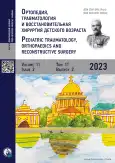Corrective shoes and inserts as treatment for flexible flatfoot in infants and children
- Authors: Wenger D.R.1, Mauldin D.2, Speck G.2, Morgan D.2, Lieber R.L.1
-
Affiliations:
- Children’s Hospital
- Texas Scottish Rite Hospital
- Issue: Vol 11, No 2 (2023)
- Pages: 253-264
- Section: Historical Article
- URL: https://journal-vniispk.ru/turner/article/view/264681
- DOI: https://doi.org/10.17816/PTORS321250
- ID: 264681
Cite item
Abstract
We performed a prospective study to determine whether flexible flatfoot in children can be influenced by treatment. One hundred and twenty-nine children who had been referred by pediatricians, and for whom the radiographic findings met the criteria for flatfoot, were randomly assigned to one of four groups: Group I, controls; Group II, treatment with corrective orthopaedic shoes; Group III, treatment with a Helfet heel-cup; or Group IV, treatment with a custom-molded plastic insert. All of the patients in Groups II, III, and IV had a minimum of three years of treatment, and ninety-eight patients whose compliance with the protocol was documented completed the study. Analysis of radiographs before treatment and at the most recent follow-up demonstrated a significant improvement in all groups (p < 0.01), including the controls, and no significant difference between the controls and the treated patients (p > 0.4).
We concluded that wearing corrective shoes or inserts for three years does not influence the course of flexible flatfoot in children.
Taken from The Journal of Bone & Joint Surgery. 71(6):800-810, Jul 1989 with the approval of publisher and Dennis R. Wenger
Keywords
Full Text
##article.viewOnOriginalSite##About the authors
Dennis R. Wenger
Children’s Hospital
Email: wenger.dr@gmail.com
ORCID iD: 0000-0002-1503-9851
MD, orthopedic surgeon
United States, San Diego, CaliforniaDonald Mauldin
Texas Scottish Rite Hospital
Email: wenger.dr@gmail.com
MD, orthopedic surgeon
United States, Dallas, TexasGail Speck
Texas Scottish Rite Hospital
Email: wenger.dr@gmail.com
MD, orthopedic surgeon
United States, Dallas, TexasDean Morgan
Texas Scottish Rite Hospital
Author for correspondence.
Email: wenger.dr@gmail.com
MD, orthopedic surgeon
United States, Dallas, TexasRichard L. Lieber
Children’s Hospital
Email: rlieber@sralab.org
ORCID iD: 0000-0002-7203-4520
Scopus Author ID: 7004711931
PhD, Professor of Physical Medicine and Rehabilitation and Neuroscience
United States, San Diego, CaliforniaReferences
- Asher C. Postural variations in childhood. London: Butterworth; 1975.
- Bleck EE, Berzins UJ. Conservative management of pes valgus with plantar flexed talus, flexible. Clin Orthop. 1977;122:85–94.
- Bordelon RL. Correction of hypermobile flat foot in children by molded insert. Foot Ankle. 1980;3(1):143–149. doi: 10.1177/107110078000100303
- Dixon WJ. BMDP statistical software. Los Angeles: University of California Press; 1983.
- Giannestras NJ. Foot disorders. Medical and surgical management. Philadelphia: Lea and Febiger; 1973.
- Giladi M, Milgrom Ch, Stein M, et al. The low arch, a protective factor in stress fractures. A prospective study of 295 military recruits. Orthop Rev. 1985;14(11):709–712.
- Harms RI, Beath T. Hypermobile flat-foot with short tendo achillis. J Bone Joint Surg. 1948;30A(1):116–140.
- Helfet AJ. A new way of treating flat feet in children. Lancet. 1956;270(6911):262–264. doi: 10.1016/s0140-6736(56)91187-4
- Henderson WH, Campbell JW. UCBL shoe insert casting and fabrication. Technical report 53. San Francisco and Berkeley: Biomechanics Laboratory, University of California; 1967
- Staheli LT, Griffin L. Corrective shoes for children: a survey of current practice. Pediatrics. 1980;65(1):13–17.
- Staheli LT, Chew DE, Corbett M. The longitudinal arch. J Bone Joint Surg. 1987;69(3):426–428.
- Stewart SF. Footgear – its history, uses, and abuses. Clin Orthop. 1972;88:119–130. doi: 10.1097/00003086-197210000-00022
- Tachdjian M.O. The child’s foot. Philadelphia: W.B. Saunders; 1985.
- Vanderwilde R, Staheli LT, Chew DE, et al. Measurements on radiographs of the foot in normal infants and children. J Bone Joint Surg. 1988;70(3):407–415.
- Wenger DR, Mauldin D, Morgan D, et al. Foot growth rate in children age one to six years. Foot Ankle. 1983;3(4):207–210. doi: 10.1177/107110078300300405
- Wynne-Davies R. Acetabular dysplasia and familial joint laxity: two etiological factors in congenital dislocation of the hip. J Bone Joint Surg. 1970;52(4):704–716.
Supplementary files


















